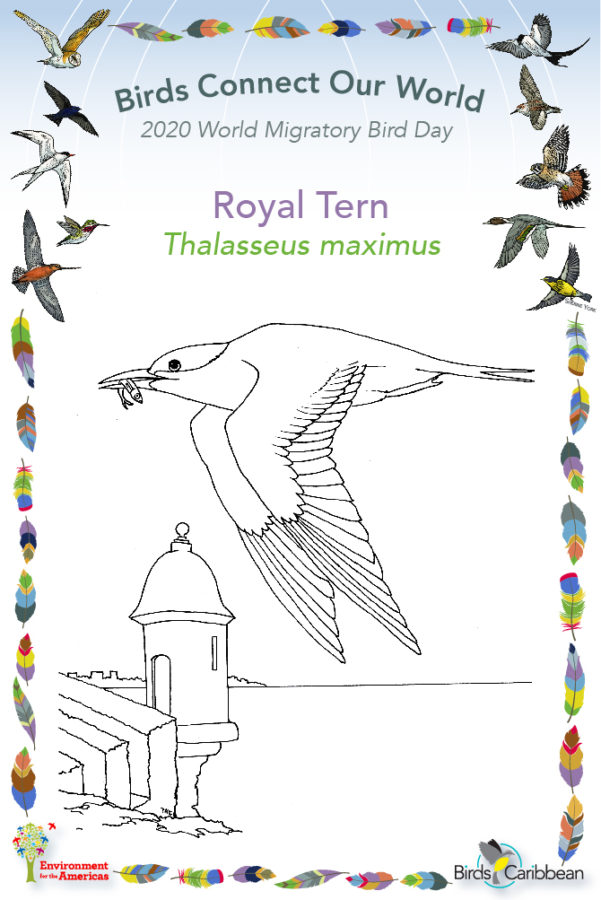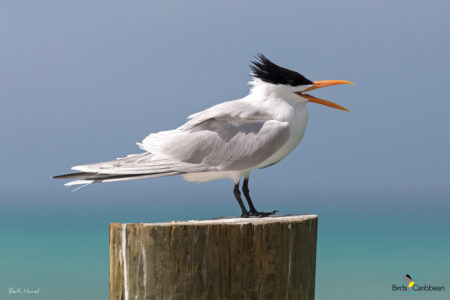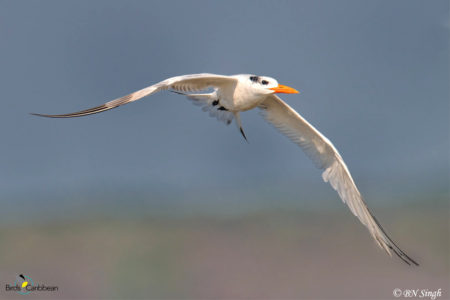Celebrate World Migratory Bird Day (WMBD) with us in our virtual “Birds Connect Our World” edition! Have fun learning about a new migratory bird every day. We have colouring pages, puzzles, activities, and more. Download for free and enjoy nature with your family at home.

Migratory Bird of the Day: Royal Tern

Royal Terns are elegant white seabirds with a black cap. Tern identification can be tricky as there are many tern species that share the same white body, long pointed wings, and black cap. While they look similar, these species all have different field marks and behaviors that can make identification fun and easy once you get to know them! The best way to tell Royal Terns from other Caribbean terns is by their large size, long, bright, carrot-orange beak, and forked tail. During the breeding season, Royal Terns have a black cap and shaggy black crest. In the winter the top of the head turns white but they retain the black crest. Immature birds look similar to non-breeding adults but their beak is more yellow and their back may be speckled.
Royal Terns are almost always found near the coast—they don’t visit inland areas often. Royal Terns are expert hunters, hovering and then plunge-diving into the water to catch small fish. Some Royal Terns are resident in the Caribbean and can be found here year-round. They are the largest tern species that breeds in the Caribbean. During the breeding season from May to August, Royal Terns form big colonies on isolated cays and islands to raise their chicks. In the Caribbean, they often share colonies with Sandwich Terns. After chicks hatch, they form large groups called crèches that stay together while parents are off catching food. Parents can recognize their own chicks from the rest of the group by their call!
During the winter their numbers increase as the local residents are joined by migratory individuals from further north in the US. In the winter, you might see flocks of Royal Terns resting or “loafing” on sandy flats near shallow water, mudflats, beaches, docks, or pilings or buoys in the water. Royal Terns are declining in parts of the Caribbean, probably because of loss of breeding habitats and human disturbance. You can help by staying away from nesting colonies during the summer so that parents can safely raise their chicks. Learn more about this species, including its range, photos, and calls here.
Colour in the Royal Tern!
Download the page from Migratory Birds of the West Indies Colouring Book. Use the photos below as your guide, or you can look up pictures of the bird online or in a bird field guide if you have one. Share your coloured-in page with us by posting it online and tagging us @BirdsCaribbean #WMBD2020Carib
Listen to the call of the Royal Tern
The call of the Royal Tern is a rasping high-pitched “Kri-i-ik.”
Puzzle of the Day
Click on the images below to do the puzzles. You can make the puzzle as easy or as hard as you like – for example, 6, 8, or 12 pieces for young children, all the way up to 1,024 pieces for those that are up for a challenge!


Activity of the Day
FOR KIDS: Royal Terns hunt for small fish by sight, they scan the water looking then dive in to pick  out the fish with their beak! Can you also hunt for fish and help the Tern find a meal? There are 10 fish for the hungry Tern to eat. And the locations can be found here.
out the fish with their beak! Can you also hunt for fish and help the Tern find a meal? There are 10 fish for the hungry Tern to eat. And the locations can be found here.
FOR KIDS AND ADULTS:
- Take a walk at beach or wetland and see if you can spot any terns. Use a bird field guide or the FREE Merlin bird ID app to help you identify the birds you are seeing.
- Enjoy the videos below of Royal Terns! The first video shows a bird with a fish at the water’s edge. The second video shows two birds engaged in pre-copulatory behavior – male standing on the female’s back – which they often do for a few minutes before copulating. Then the male is shown walking around and giving an aggressive display to nearby birds called Aggressive-Upright – the wings are held low and away from the body, and the head is held high with bill up or horizontal. This display may be given when adults are protecting young, when they are walking through or a colony, or when they are approached by other birds during courtship activities.
- Visit MigratoryBirdDay.org for many more free activities and resources to learn about migratory birds, their threats and conservation actions you can take.
